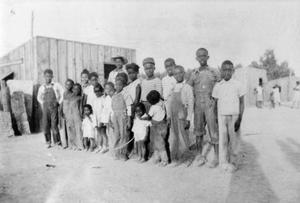Editor’s note: In honor of Black History Month, inmaricopa.com is running a series focusing on the heritage of the black community in the Maricopa area.
As the sun settled that night years ago, Sam Craig Jr., his parents and his seven siblings left their home and took refuge in the darkness.
It was necessary for the black family to hide because if they were discovered trying to leave the confines of their Texas employer, the consequence could be deadly.
“Back then, they could essentially make up any reason to kill you,” Craig said.
So the family, along with several others, huddled in the dark waiting for the driver of an old Army truck to pull up and take them on to a better place with a more promising future.
They waited for someone to take them West.
In the 1940s, as many Arizonans left to fight overseas or found new war-industry jobs, the exodus left a substantial void in the farm labor force, which greatly hindered agricultural production in the state.
To help remedy the lack of available manpower, Arizona growers began to increase their recruitment of workers from the Southern Plains states.
One of the methods the farms used to draw field workers away from other states was to offer better wages and working conditions than the laborers had in their current positions.
“In Texas, they were paying us 75 cents a day, but in Arizona they were offering $3 per 100 pounds of cotton picked. I could pick 500 pounds a day,” said Craig, who was a teenager when he migrated to Arizona.
Craig’s family had heard about these better conditions out West in the same manner many other families had – through word of mouth.
“Farm bosses would constantly ask you if you knew where to get more workers, and if you did, they would ask you to go convince them to leave their current employer and come to Arizona,” Craig said.
However, the farm owners would not only send the worker to recruit, they would hire drivers and send then in trucks to bring back workers by the hundreds.
To ensure the safety of those involved in the trip, Craig said that the first truck that the workers boarded would have Texas plates in order to not raise suspicion among local farmers, but then they would switch to a vehicle with Arizona plates in San Antonio.
Once these workers would arrive in the Stanfield/Maricopa area, they would be broken into groups of four and each group would be placed in a 400-square-foot shack.
“The living quarters were small but they served the purpose,” Craig said.
These families that came to the area to work the fields formed a tight-knit community, attending a church that was built on the farm and often heading over to the Stanfield movie theater. However, many of the workers were only seasonal and soon as the work dried up, they would return to Texas.
“Many of the people who came out to work would often come up just for the growing season, then return to Texas, but eventually they would save enough money doing this over the years to move to the West permanently,” said Sam Craig’s brother, Hareld.
Hareld added that this is how many of the black families in California, Arizona and other Western states migrated to the area.
According to the U.S. Census, the number of blacks in Pinal, Maricopa and Pinal counties to grew from 2,000 in 1920 to more than 10,000 by the 1940s.
The Craig family was lucky enough to be one of the families who did not have to make multiple commutes.
“Me and my father got into irrigation and that is work that runs year-round,” Sam Craig said.
That irrigation work would lead to the family planting their roots in the county.
“Our family went from working in Stanfield, to Casa Grande and even to a farm out in Coolidge,” Craig said. “All the people in Pinal County always treated our family real good.”
The Craig family remains in Arizona today and preaches the importance of the black community remembering their roots.
“It is very important for the younger generations to know their history,” Hareld said.
Photos courtesy of the Craig family



![Elena Trails releases home renderings An image of one of 56 elevation renderings submitted to Maricopa's planning department for the Elena Trails subdivison. The developer plans to construct 14 different floor plans, with four elevation styles per plan. [City of Maricopa]](https://www.inmaricopa.com/wp-content/uploads/2024/04/city-041724-elena-trails-rendering-218x150.jpg)

![Affordable apartments planned near ‘Restaurant Row’ A blue square highlights the area of the proposed affordable housing development and "Restaurant Row" sitting south of city hall and the Maricopa Police Department. Preliminary architectural drawings were not yet available. [City of Maricopa]](https://www.inmaricopa.com/wp-content/uploads/2024/04/041724-affordable-housing-project-restaurant-row-218x150.jpg)










![Elena Trails releases home renderings An image of one of 56 elevation renderings submitted to Maricopa's planning department for the Elena Trails subdivison. The developer plans to construct 14 different floor plans, with four elevation styles per plan. [City of Maricopa]](https://www.inmaricopa.com/wp-content/uploads/2024/04/city-041724-elena-trails-rendering-100x70.jpg)

![Affordable apartments planned near ‘Restaurant Row’ A blue square highlights the area of the proposed affordable housing development and "Restaurant Row" sitting south of city hall and the Maricopa Police Department. Preliminary architectural drawings were not yet available. [City of Maricopa]](https://www.inmaricopa.com/wp-content/uploads/2024/04/041724-affordable-housing-project-restaurant-row-100x70.jpg)